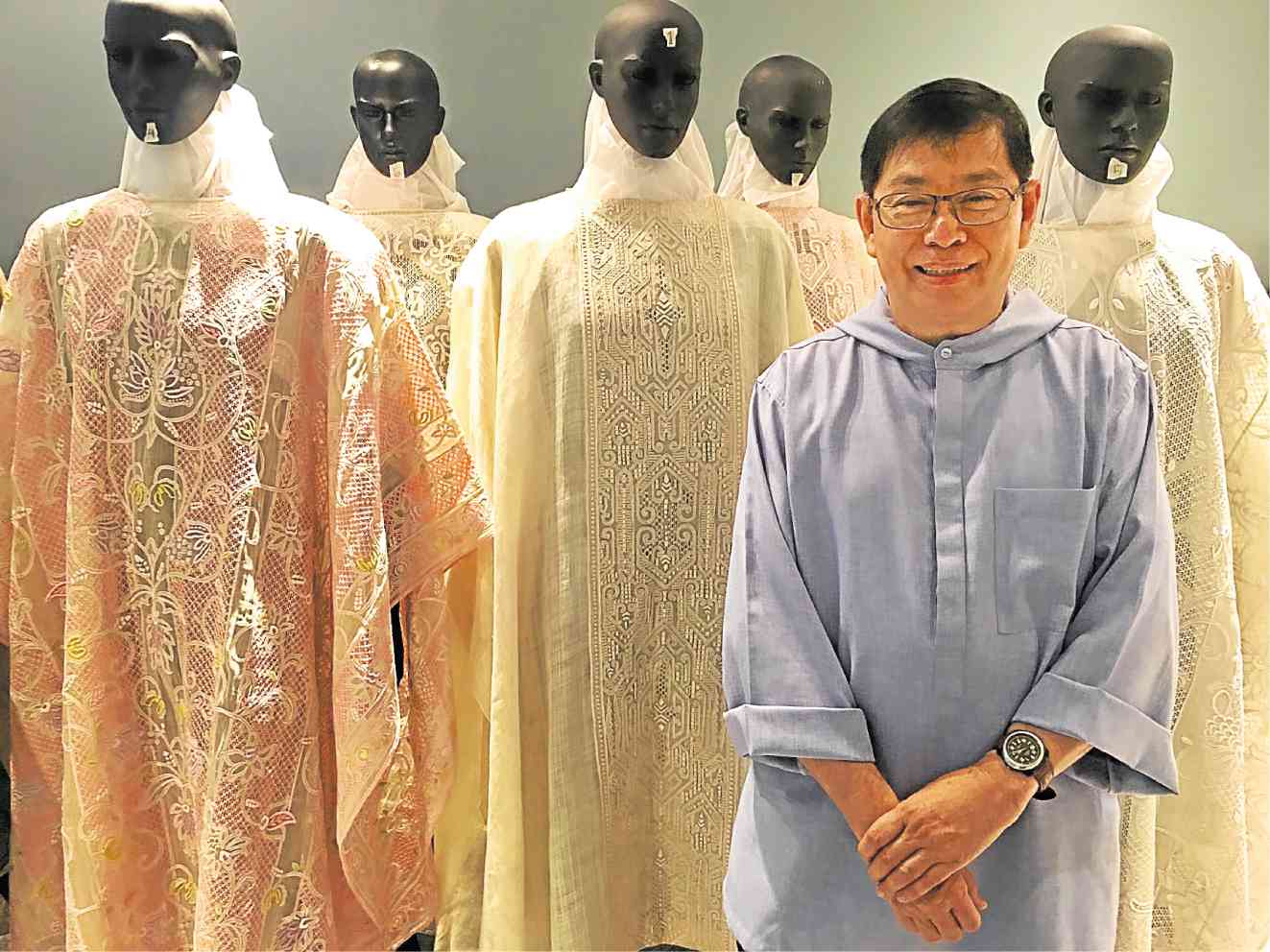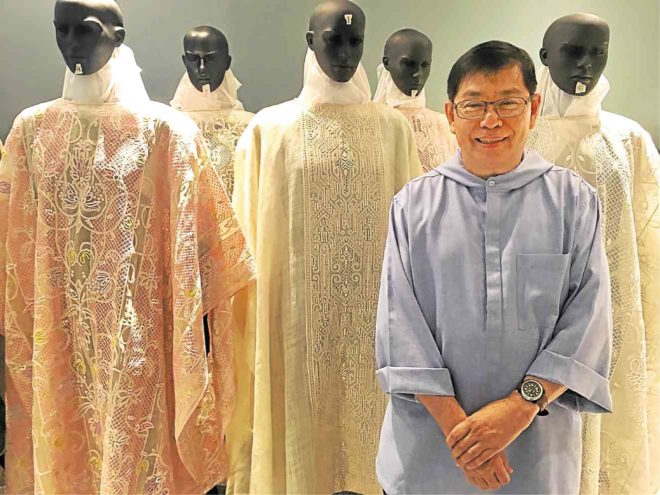
It has been nearly 20 years since Dom Martin de Jesus H. Gomez, OSB, exhibited a 50-piece collection of liturgical vestments of his making. It was the centennial offering of the old Ayala Museum.
The Benedictine monk, known to society as former fashion designer Gang Gomez, is reshowing the collection with new pieces in a comeback exhibit at Ayala Museum beginning June 5 (it runs until July 23).
Indigenous fabrics
While the original show focused on indigenous Filipino fabrics, the 60-piece “Vestments for Worship: Wrapped in Identity” exhibit highlights original Filipino embroidery designs, the maker’s reaction to the notion that the country has no original embroidery.
“When I was doing my research in 1996, I came across journals of foreign anthropologists who came here in the 19th and early 20th centuries,” Gomez said.
“They said that we have exquisite embroidery here, but no original designs. According to them, they were poor imitations of Spanish originals. But what they saw were the ones that were taught to the women of the pueblos by the Spanish nuns. If they went deeper into the jungles, the indigenous tribes had designs that were not touched by foreign influence, like the T’boli. So I emphasized that.”
After the six-month centennial exhibit years ago, the vestments were permanently housed at the Monastery of the Transfiguration museum in Malaybalay, Bukidnon, where Gomez continued to grow the collection, sketching designs here and there, creating pieces in the last 19 years as part of his artistic expression, and in continuation of an advocacy of the Church called “inculturation.”
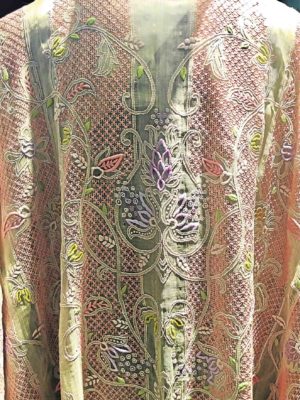
Inculturation, put simply, means adapting the Church’s teachings to coexist with local cultures.
“Four hundred years ago, when the Spaniards came, they imposed what they were wearing,” Gomez said. “The first priests, as a conquered people, had no questions. They were just eager to wear what the Spaniards were wearing—even if they were perspiring, since the vestments were made of rich velvets and heavy brocades, and not meant for the tropical weather.”
In the 1950s to the ’60s, music inculturation started to happen, with Filipino hymns, and later the local dialects. Roman Catholic architecture also began to evolve with the building of churches made of materials like adobe, narra, bamboo, Gomez noted.
Vestments untouched
“As late as 20 years ago, in the 1990s, vestments were hardly touched, at least not on a national level,” he added. “In Baguio, as early as the 1980s, you can buy stoles woven by the Igorot. Also in Davao by the indigenous groups there. But all were made of synthetic polyesters and acrylic because they were the vogue in the ’60s until the ’70s. It was what was easily available, and was cheaper. Sayang!”
During his research, Gomez asked the then chair of the Commission on the Liturgy why there had been no move to include vestments in the inculturation process. “He said, ‘Maybe they’re waiting for you to do something.’ He knew I was a designer for 20 years.”
Gomez was a contemporary of Joe Salazar, Inno Sotto and Auggie Cordero.
The original vestment collection consisted of all-natural handwoven Filipino fabrics like piña, abaca, banana silk. Gomez revisited the country’s weaving traditions and worked with the weaving centers.
“It started as a liturgical exhibit but it also became an anthropological, sociological enterprise,” Gomez said of his work, which was made into a book called “Worship and Weave: Towards Filipino Liturgical Vestments,” and won the National Book Award for Art in 2001.
“I did fieldwork among the tribes. It was part of my liturgical studies. Before the designing was the heavy research.”
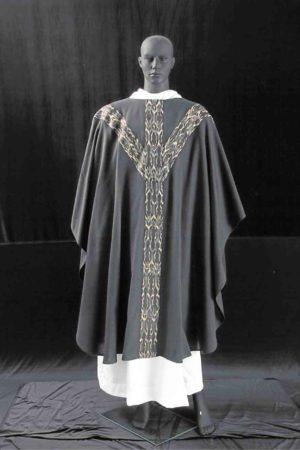
New museumgoers
Last year, a group who came to visit the abbey urged Gomez to bring back the collection to Manila since, they reasoned, “there’s a new set of museumgoers every 10 years.” The visitors included anthropologist and businesswoman Patricia Araneta, and Ayala Museum director Mariles Gustilo.
But people familiar with Gomez’s work wouldn’t be surprised that his liturgical project would also emphasize the indigenous, as it was also his preferred material when he was a fashion designer.
“I was known for Filipino-inspired collections,” he said. “My idea of Filipino fashion was to use indigenous materials—take the best that the country had, and mix with the best of what the rest of the world has to offer. Modernize and upgrade. I’ll use barong material but I won’t sew it as a kimona.”
Landed clan
Born Edgardo Ramon Hizon Gomez, the monk is a scion of a landed clan from San Fernando, Pampanga. Short of a master’s thesis in his Philosophy studies at the University of Santo Tomas, he left for New York to study fashion. For 20 years, he had a thriving career dressing high society women, until he decided, in 1990, to close shop and enter the monastic life.
“I would be lying if I say I didn’t enjoy my life before that. I did, very much, but I was longing for something else, that serenity, and I found that in the monastery.”
With his superiors’ blessings, Gomez was able to continue to pursue his creative leanings in the abbey. In fact, the abbot who approved his vestment project planned it to be viable since “a lot of Benedictine abbeys make vestments as a source of income.”
After several pieces were shown at the Textile Museum of Canada, the monk was swamped with orders of the top-of-the-line pieces, priced up to $3,000 apiece.
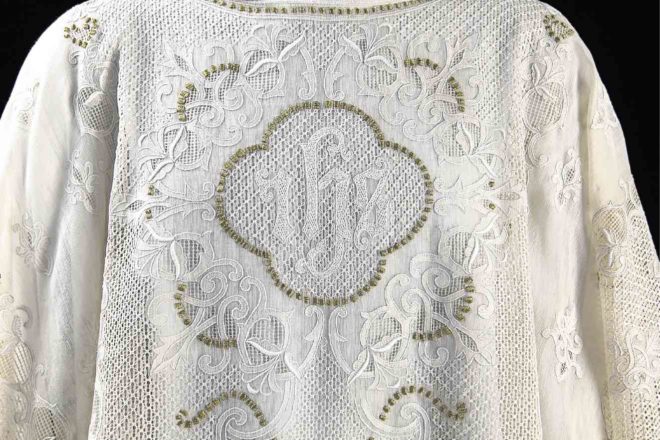
Other plans
The plan fell through as the abbot fell ill, and his replacement had other plans for Gomez. Thinking all his hard work were for naught, “I cried for three nights!” he recalled. “Now they’re more open.”
In 2018, they plan to produce the vestments commercially. “I’m semiretired after my heart operation three years ago, so they lessened my responsibilities,” he said. “I have more time to design. They said, ‘What you can do is not to take orders but continue to make. Post it on the internet, and they can contact us if they’re interested’.”
On June 9, Gomez will hold a lecture at Ayala Museum with a guided tour of the exhibit.
He hopes that, apart from design students and enthusiasts, vestment makers would attend “because some are not so faithful to the guidelines and there are guidelines, there are general instructions of the Roman missal. There are parameters. Hindi puedeng basta maganda. I’m very gentle in suggesting. I think they will take it positively when I talk about what to avoid.”
He added, “As Benedictines we use the classical requirements of arts, which is noble simplicity. There has to be a sense of harmony. Hindi puedeng dahil maganda puede mong ilagay. Hindi mo puedeng basta dagdagan.”
60 pieces
His new designs—there will be 60 pieces on exhibit—will include his take on the zigzags and the rhombuses of the T’boli’s t’nalak; embroidery inspired by the pako fern used by the Maranao in the malong; single-color abel Iloko “which is never done,” among others.
All embroidery was done by the bordadoras of Lumban.
“All the fabrics are handwoven, the embroidery done by hand,” he said. “For the ornamentation, the tassels were carved mother-of-pearl, which I found were common among the Gaddang of the north and T’boli of the south. The problem with us now, we always like to emphasize the differences instead of the commonalities between Luzon, Visayas and Mindanao, when 100 years ago, we were one.”
He had had to convince the tribal communities to experiment with new looms, new colors and yarns, and new designs.
“Tribes are resistant. They’re very traditional and suspicious of outside influence. They have this feeling that if they adjust to modern times, their culture might die. I had to convince them that it’s the opposite, that little by little you have to adjust to the times. Your culture needs to adjust or it will stagnate. You give it another 50 years, wala ng gagawa n’yan. Try new colors, new yarn, new fibers, while still doing your traditional. Then it becomes interesting, profitable, and your daughters will realize there’s money in it.”
In November, a select number of vestments will be shown at the Philippine Center in Manhattan, where Gomez did fashion shows 30 years ago—a feat that delights the former designer no end since, he said, it would crystallize his life work.
“People like to say that I’ve reinvented myself. But it’s not really a reinvention. It’s a fulfillment of a plan—God’s plan.”


